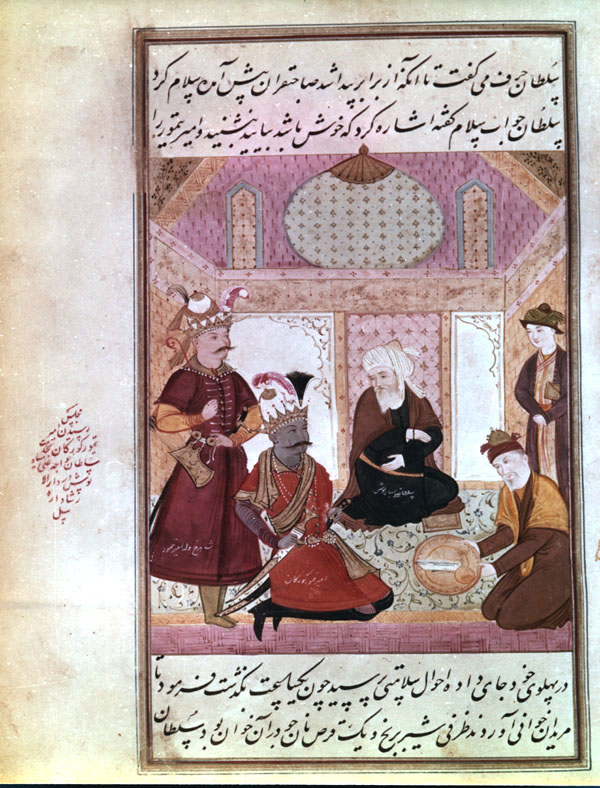Manuscripts
tāriḵ-e ʿālām-ārā-ye šāh esmāʿil
Several years after the incident in which Ḵˇāja ʿAli returned the whip (see folio 13), Timur was returning from his campaign in Asia Minor with a large number of prisoners. The fame of Shaikh Ṣafi’s shrine was widespread, and Timur stopped at Ardabil to make a pilgrimage to the Safavid mausoleum. When Timur questioned the attendants, the darvishes directed him to Ḵˇāja ʿAli’s private quarters, only to find him at prayer. Upon completion of his prayers, Ḵˇāja ʿAli had the conqueror seated in the proper manner, and offered him words of counsel and admonition. In response, Timur vowed to commit himself to the Ḵˇāja’s spiritual direction, if the mystic could reveal three things of which the emir was thinking. Khvåjeh ¯Ali successfully revealed all three things, prompting Timur to offer him any request (Different versions are given by different sources - see Savory, Development, p.23). Since Ḵˇāja ʿAli was completely free of worldly considerations, he requested that Timur release all his prisoners. Timur complied, and with his own money bought pasture land for them in the area of Ardabil, and presented it as a vaqf to the Safavid sanctuary.
The painting illustrates the meeting of Timur and Sultan Ḵˇāja ʿAli in the latter’s private quarters. The elderly white-bearded Ḵˇāja, clad in brown and black with a white turban, is seated in front of (perhaps intended to be inside of) a domed, tiled, hexagonal pavilion of pastel colors. He looks in the direction of Emir Timur who, clad in red with black boots, kneels before him. As in folio 13 Timur is portrayed dark-skinned in the traditional representation of an Indian. Behind Timur stands his son, Shah Roḵ, dressed in maroon and holding a quiver. Off to the right are two attendants dressed in brown and orange. One kneels with a tray, the other stands with an envelope under his arm.

Painting: 15.5 x 13.0 cm. Two lines of text above and below the painting; frame encloses painting and text. No apparent sign of damage or retouching. A marginal inscription in red, presumably of later date, describes the event depicted. Inscriptions in white by the same hand as in the margin are written on three figures, identifying them as Timur, Shah Roḵ, and Sultan ʿAli Siāh Puš.
Painting references:
Mahboubian_1972, #923 folio 17 (not illustrated).
Text X-references:
See Muntaẓer-Ṣāḥeb_1970, p.19 for this event in the History of Shah Esmāʿil.
See Savory, SA_1979, pp.27-28 for this event in the History of Shah ʿĀbbās.
Savory, Development_1958, p.23
Robert Eng
Last Updated: December 1, 2010
Originally published: April 4, 2002